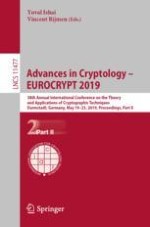2019 | OriginalPaper | Chapter
Building an Efficient Lattice Gadget Toolkit: Subgaussian Sampling and More
Authors : Nicholas Genise, Daniele Micciancio, Yuriy Polyakov
Published in: Advances in Cryptology – EUROCRYPT 2019
Publisher: Springer International Publishing
Activate our intelligent search to find suitable subject content or patents.
Select sections of text to find matching patents with Artificial Intelligence. powered by
Select sections of text to find additional relevant content using AI-assisted search. powered by
